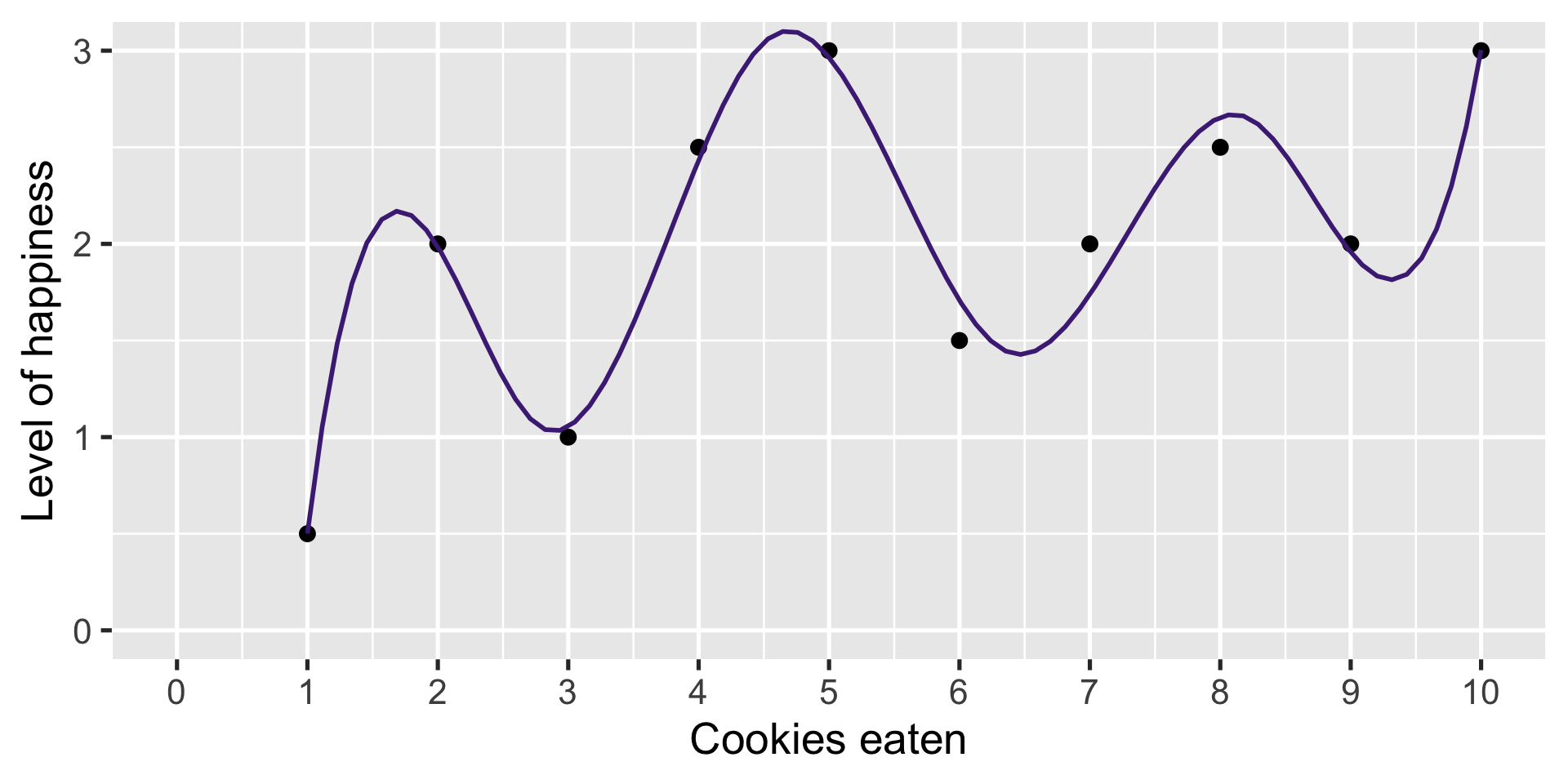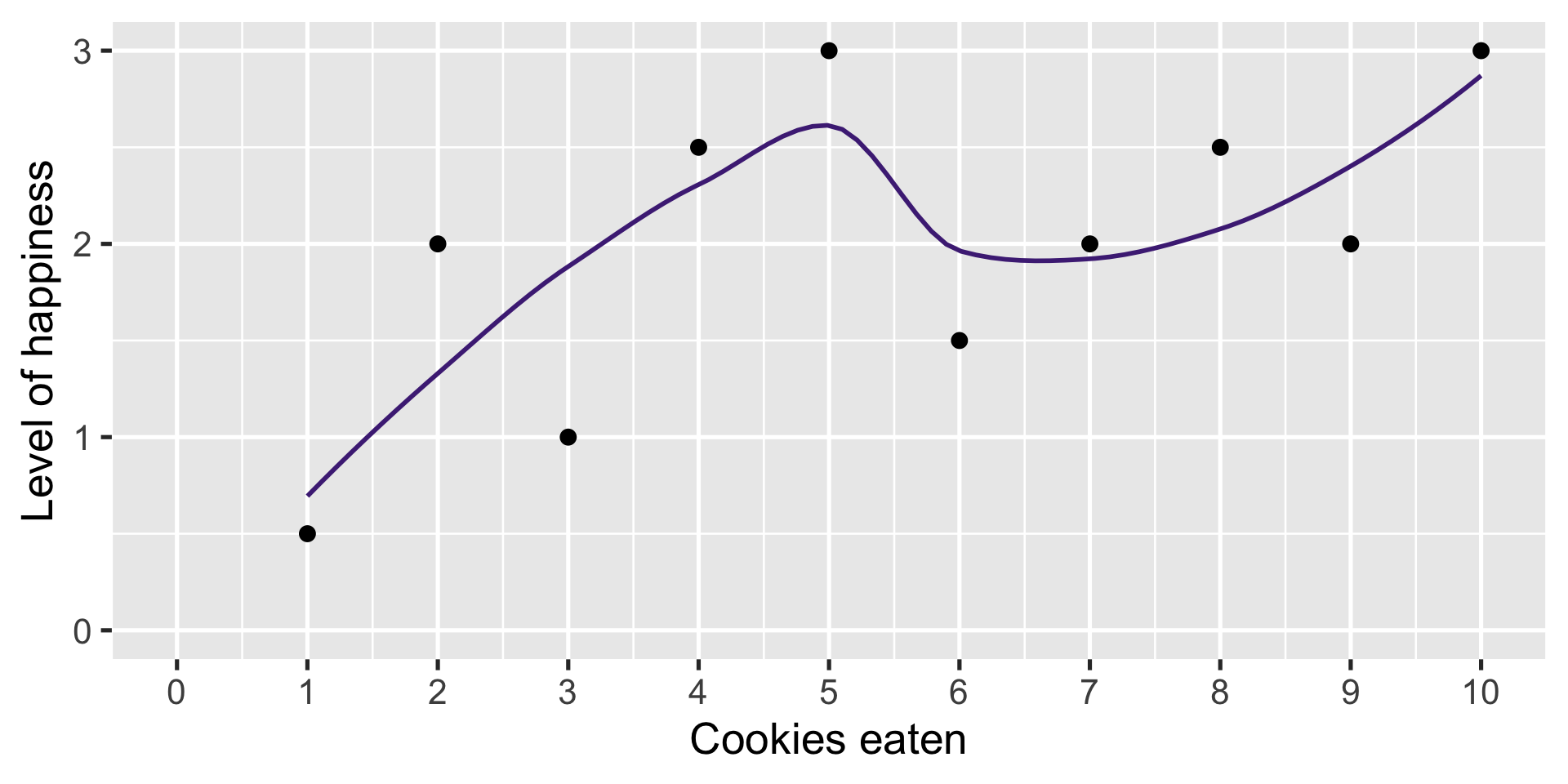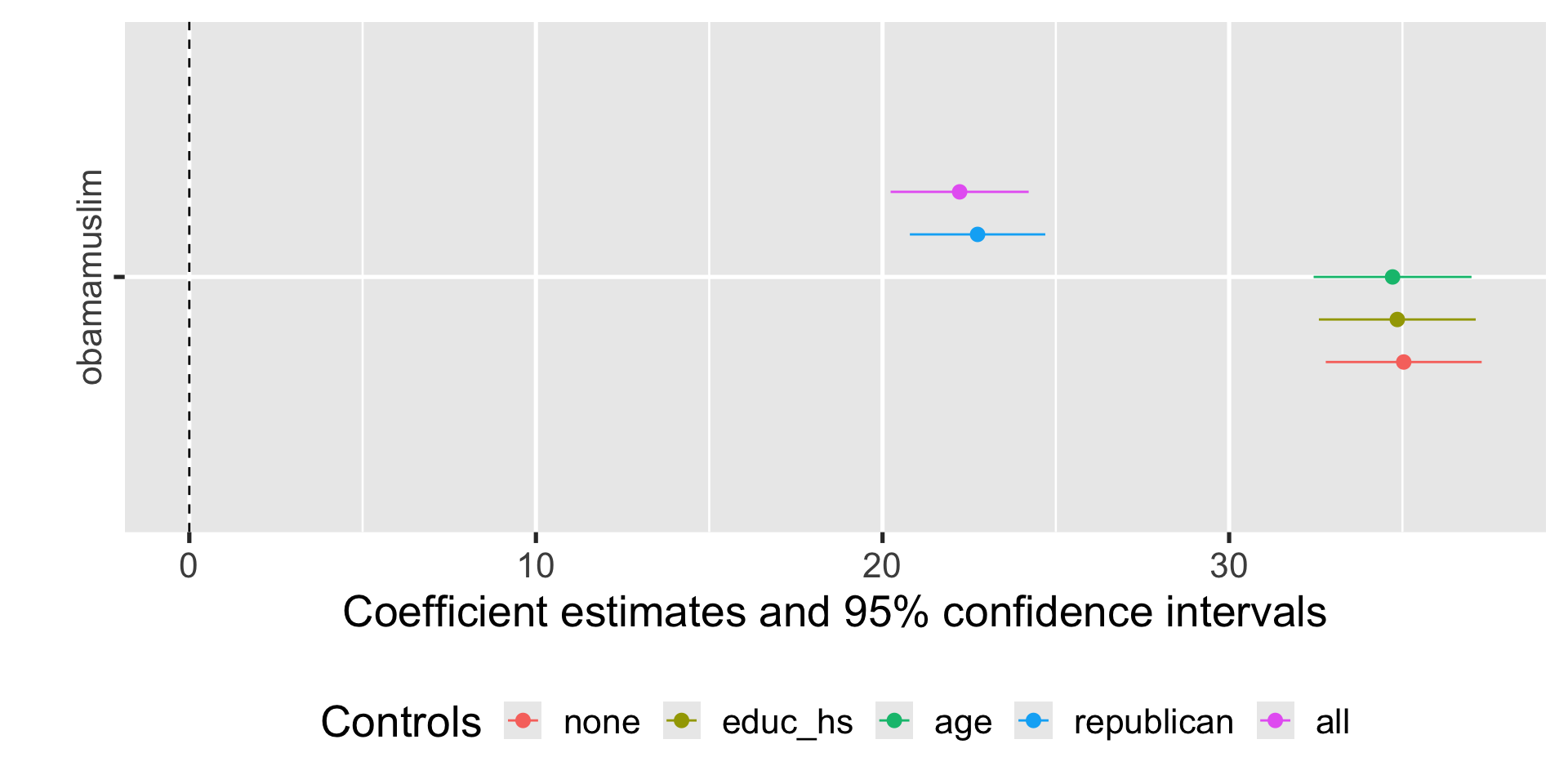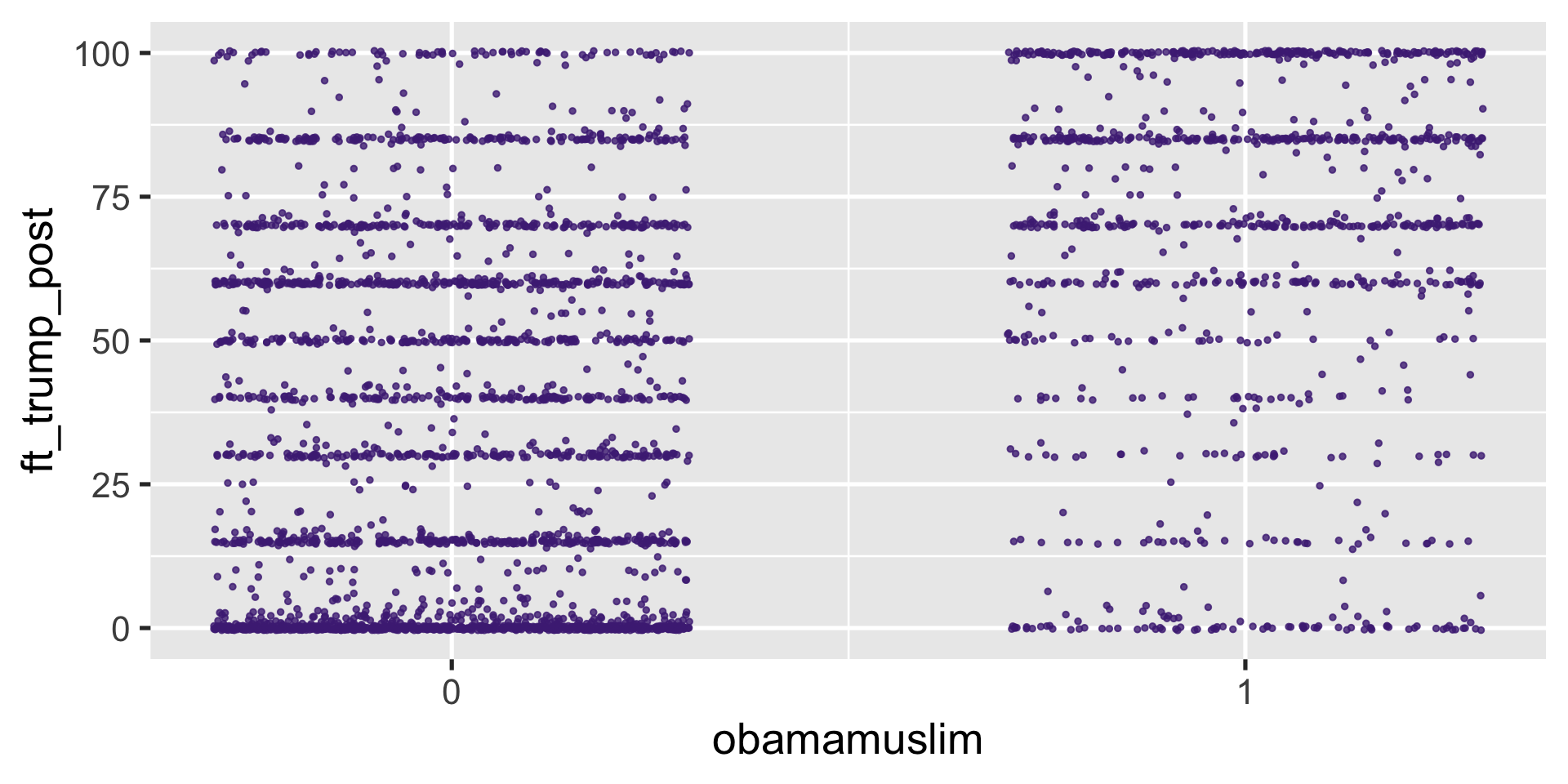
Regression
POLI_SCI 403: Probability and Statistics
Agenda
Bivariate regression
Multivariate regression
Inference (lab)
Regression with matrix algebra (if we have time)
Bivariate regression
So far
Ingredients for statistical inference
Estimand \(\theta\)
Estimator \(\widehat \theta\)
Data \(X\)
Estimate \(\overline X\)
Quantify uncertainty (confidence intervals, p-values)
\(X \rightarrow \widehat{\theta} \rightarrow \overline{X} \xrightarrow{\text{hopefully!}} \theta\)
MSE and expected value
\[ \text{MSE} = E[(X-\color{purple}c)^2] \]
Alternative formula
\[ \text{MSE} = V[X] + (E[X] - \color{purple}c)^2 \]
\(E[X]\) minimizes MSE
\[ \text{MSE} = V[X] + (E[X] - \color{purple}{E[X]})^2 \]
In practice
This is all about one variable at a time!
We usually want to tell more nuanced stories:
- Difference between/across groups
- Relationship between two variables
- Difference in the relationship between two variables between/across groups
Toy example

How to summarize?

Connect with a line

Maybe smoother?

A straight line?

Straight lines are good
They can be written as a linear equation
\[ y = a + bx \]
| \(y\) | Outcome variable |
| \(x\) | Explanatory variable |
| \(b\) | Slope (\(\frac{\text{rise}}{\text{run}}\)) |
| \(a\) | y-intercept |
This is the smallest number of parameters to draw a line
We can think of intercept and slope as estimands
Straight lines are good
They can be written as a linear equation
\[ Y = \alpha + \beta X \]
| \(Y\) | Outcome variable |
| \(X\) | Explanatory variable |
| \(\beta\) | Slope (\(\frac{\text{rise}}{\text{run}}\)) |
| \(\alpha\) | y-intercept |
This is the smallest number of parameters to draw a line
We can think of intercept and slope as estimands
Conditional expectations
CEF \(E[Y|X]\) minimizes MSE of \(Y\) given \(X\)
If we restrict ourselves to a linear functional form \(Y = a + bX\)
then the following minimize MSE of \(Y\) given \(X\):
- \(g(X) = \alpha + \beta X\) where
- \(\alpha = E[Y] - \frac{\text{Cov}[X,Y]}{V[X]}E[X]\)
- \(\beta = \frac{\text{Cov}[X,Y]}{V[X]}\)
So it’s really all about \(\beta\)
Aside: Regression and correlation
Informally, we use regression coefficients (slopes) to determine whether two variables are correlated
Technically, they are related but on a different scale
Regression coefficient: \(\beta = \frac{\text{Cov}[X,Y]}{V[X]}\)
Correlation: \(\rho = \frac{\text{Cov}[X,Y]}{SD[X] SD[Y]}\)
Aside: Regression and correlation
Informally, we use regression coefficients (slopes) to determine whether two variables are correlated
Technically, they are related but on a different scale
Regression coefficient: \(\beta = \frac{\text{Cov}[X,Y]}{V[X]}\) \(\Rightarrow\) in units of Y (happiness)
(Pearson’s) correlation: \(\rho = \frac{\text{Cov}[X,Y]}{SD[X] SD[Y]}\)
Aside: Regression and correlation
Informally, we use regression coefficients (slopes) to determine whether two variables are correlated
Technically, they are related but on a different scale
Regression coefficient: \(\beta = \frac{\text{Cov}[X,Y]}{V[X]}\) \(\Rightarrow\) in units of Y (happiness)
(Pearson’s) correlation: \(\rho = \frac{\text{Cov}[X,Y]}{SD[X] SD[Y]}\) \(\Rightarrow\) [-1, 1] scale
What are we doing?
Before: Assume there is a true parameter that we do not observe (e.g. population mean, ATE)
Now: Assume there is a true line that best describes the relationship between X and Y
There is a best linear predictor that we want to estimate
But how do we find it!?
Which line is a better summary?

More formally
The best linear predictor is the line that minimizes the distance of each observation to the line
That distance is known as residual or error
Visualizing residuals
Visualizing residuals
More formally
The best linear predictor is the line that minimizes the distance of each observation to to the line
That distance is know as a residual or error
\[ e_i = (y_i - \widehat y_i) \]
More formally
The best linear predictor is the line that minimizes the distance of each observation to to the line
That distance is know as a residual or error
\[ e_i = (y_i - (b_0 + b_1 x_{1i})) \]
Minimizing residuals
We want to find a vector of coefficients (\(\widehat \beta_0\), \(\widehat \beta_1\)) that minimizes the sum of squared residuals
\[ SSR = \sum_{i=1}^n e_i^2 \]
We could try many lines until we find the the smallest SSR
Or use a method called Ordinary Least Squares (OLS)
OLS regression by plug-in principle
Estimand
\(\alpha = E[Y] - \frac{\text{Cov}[X,Y]}{V[X]}E[X] \qquad \beta = \frac{\text{Cov}[X,Y]}{V[X]}\)
Estimator
\(\widehat\alpha = \overline Y - \frac{\overline{XY} - \overline{X} \cdot \overline{Y}}{\overline{X^2} - \overline{X}^2} \overline{X} \qquad \widehat{\beta} = \frac{\overline{XY} - \overline{X} \cdot \overline{Y}}{\overline{X^2} - \overline{X}^2}\)
Back to cookies
\[ \widehat{y} = \widehat \beta_0 + \widehat \beta_1 x_1 \]
Back to cookies
\[ \widehat{\text{happiness}} = \beta_0 + \beta _1 \text{cookies} \]
Back to cookies
\(\widehat{\text{happiness}} = \beta_0 + \beta_1 \text{cookies}\)
Back to cookies
\(\widehat{\text{happiness}} = \beta_0 + \beta_1 \text{cookies}\)

Back to cookies
\(\widehat{\text{happiness}} = \beta_0 + \beta_1 \text{cookies}\)

| happinness | |
|---|---|
| (Intercept) | 1.100* |
| (0.470) | |
| cookies | 0.164+ |
| (0.076) | |
| Num.Obs. | 10 |
| R2 | 0.368 |
| + p < 0.1, * p < 0.05, ** p < 0.01, *** p < 0.001 |
Back to cookies
\(\widehat{\text{happiness}} = \beta_0 + \beta_1 \text{cookies}\)

| happinness | |
|---|---|
| (Intercept) | 1.100* |
| (0.470) | |
| cookies | 0.164 |
| (0.076) | |
| Num.Obs. | 10 |
| R2 | 0.368 |
| * p < 0.05 |
Back to cookies
\(\widehat{\text{happiness}} = 1.10 + 0.16 \cdot \text{cookies}\)

| happinness | |
|---|---|
| (Intercept) | 1.100* |
| (0.470) | |
| cookies | 0.164 |
| (0.076) | |
| Num.Obs. | 10 |
| R2 | 0.368 |
| * p < 0.05 |
Back to cookies
\(\widehat{\text{happiness}} = 1.10 + 0.16 \cdot \text{cookies}\)

| happinness | |
|---|---|
| (Intercept) | 1.100* |
| (0.470) | |
| cookies | 0.164 |
| (0.076) | |
| Num.Obs. | 10 |
| R2 | 0.368 |
| * p < 0.05 |
On average
Back to cookies
\(\widehat{\text{happiness}} = 1.10 + 0.16 \cdot \text{cookies}\)

| happinness | |
|---|---|
| (Intercept) | 1.100* |
| (0.470) | |
| cookies | 0.164 |
| (0.076) | |
| Num.Obs. | 10 |
| R2 | 0.368 |
| * p < 0.05 |
On average, one additional cookie
Back to cookies
\(\widehat{\text{happiness}} = 1.10 + 0.16 \cdot \text{cookies}\)

| happinness | |
|---|---|
| (Intercept) | 1.100* |
| (0.470) | |
| cookies | 0.164 |
| (0.076) | |
| Num.Obs. | 10 |
| R2 | 0.368 |
| * p < 0.05 |
On average, one additional cookie increases happiness by 0.16 points
Helpful for comparison
Is 0.16 happiness points per cookie a lot?
We cannot tell without a point of reference
But correlation is a reference on its own:
| Absolute magnitude | Effect |
|---|---|
| 0.1 | Small |
| 0.3 | Moderate |
| 0.5 | Large |
Back to cookies
\(\widehat{\text{happiness}} = 1.10 + 0.16 \cdot \text{cookies}\)

| happinness | |
|---|---|
| (Intercept) | 1.100* |
| (0.470) | |
| cookies | 0.164 |
| (0.076) | |
| Num.Obs. | 10 |
| R2 | 0.368 |
| * p < 0.05 |
On average, one additional cookie increases happiness by 0.16 points
Back to cookies
\(\widehat{\text{happiness}} = 1.10 + 0.16 \cdot \text{cookies}\)

| happinness | |
|---|---|
| (Intercept) | 1.100* |
| (0.470) | |
| cookies | 0.164 |
| (0.076) | |
| Num.Obs. | 10 |
| R2 | 0.368 |
| * p < 0.05 |
On average, one additional cookie increases happiness by 0.16 points
Corresponds to \(\rho =\) 0.61
Multivariate regression
Problem
What if we wanted to include more variables?
Of course we can!
But why would we want do that?
Depends on what you want to say
Level 1: Description of conditional means
Level 2: Statistical inference (needs CIs or p-values)
Level 3: Causal inference (needs assumptions)
My take: You only care about level 2 because you have (at least) a proto-causal story
Meaning there is a focal X and Y relationship we want to measure, but it is “contaminated” by some confounder
We need to “adjust” or “control” the effect of X on Y (more in 3 weeks)
Ordinary Least Squares (OLS)
Rewrite with an arbitrary number of variables
Function \(\widehat{g} = \widehat \beta_0 + \widehat \beta_1 X_{[1]} + \widehat \beta_2 X_{[2]} + \ldots + \widehat \beta_K X_{[K]}\)
Such that
\[ \mathbf{\widehat \beta} = (\widehat\beta_0, \widehat\beta_1, \ldots, \widehat\beta_K) = \underset{(b_0, b_1, \ldots, b_K) \in \mathbb{R}^{K + 1}}{\text{argmin}} \frac{1}{n} \sum_{i = 1}^n e_i^2 \]
Where \(e_i = (Y_i - (b_0 + b_1 X_{[1]i} + b_2 X_{[2]i} + \ldots + b_K X_{[K]i}))\)
Ordinary Least Squares (OLS)
Rewrite with an arbitrary number of variables
Function \(\widehat{g} = \widehat \beta_0 + \widehat \beta_1 X_{[1]} + \widehat \beta_2 X_{[2]} + \ldots + \widehat \beta_K X_{[K]}\)
Such that
\[ \mathbf{\widehat \beta} = (\widehat\beta_0, \widehat\beta_1, \ldots, \widehat\beta_K) = \underset{(b_0, b_1, \ldots, b_K) \in \mathbb{R}^{K + 1}}{\text{argmin}} \frac{1}{n} \sum_{i = 1}^n e_i^2 \]
Where \(e_i = (Y_i - \widehat Y_i)\)
Ordinary Least Squares (OLS)
Rewrite with an arbitrary number of variables
Function \(\widehat{g} = \widehat \beta_0 + \widehat \beta_1 X_{[1]} + \widehat \beta_2 X_{[2]} + \ldots + \widehat \beta_K X_{[K]}\)
Such that
\[ \mathbf{\widehat \beta} = (\widehat\beta_0, \widehat\beta_1, \ldots, \widehat\beta_K) = \underset{(b_0, b_1, \ldots, b_K) \in \mathbb{R}^{K + 1}}{\text{argmin}} \frac{1}{n} \sum_{i = 1}^n e_i^2 \]
Where \(e_i = (\text{actual} - \text{predicted})\)
ANES 2016 data
Variables
nes16 = timeseries_2016 %>%
select(
V162079, # Feeling thermometer for TRUMP [POST]
V162230x, # Better if man works and woman takes care of home [POST]
V162255, # Is Barack Obama Muslim (yes/no) [POST]
V161267, # Respondent Age [PRE]
V161270, # Highest level of Education (Years) [PRE]
V161158x # Party ID [PRE]
)# A tibble: 4,270 × 6
V162079 V162230x V162255 V161267 V161270 V161158x
<hvn_lbll> <hvn_lbll> <hvn_lbll> <hvn_lbll> <hvn_lbll> <hvn_lbll>
1 85 4 2 29 9 7
2 60 4 1 26 13 6
3 70 1 1 23 9 3
4 60 1 2 58 9 5
5 15 4 1 38 9 3
6 65 4 -8 60 14 5
7 50 4 -8 58 5 1
8 85 1 1 56 9 4
9 70 4 2 45 9 5
10 60 4 -8 30 10 3
# ℹ 4,260 more rowsRecode
nes16 = nes16 %>%
mutate(
ft_trump_post = ifelse(V162079 < 0 | V162079 == 998, NA, V162079),
women_at_home = case_when(V162230x < 0 ~ NA,
V162230x <= 3 ~ 1,
V162230x <= 7 ~ 0),
obamamuslim = ifelse(V162255 == 1, 1, 0),
age = ifelse(V161267 < 0, NA, V161267),
age0 = age - 18,
educ_hs = case_when(V161270 < 0 ~ NA,
V161270 >= 90 ~ NA,
V161270 >= 9 ~ 1,
V161270 <= 8 ~ 0),
republican = case_when(V161158x < 0 ~ NA,
V161158x <= 4 ~ 0,
V161158x <= 7 ~ 1)
)# A tibble: 4,270 × 7
ft_trump_post women_at_home obamamuslim age age0 educ_hs republican
<dbl> <dbl> <dbl> <dbl> <dbl> <dbl> <dbl>
1 85 0 0 29 11 1 1
2 60 0 1 26 8 1 1
3 70 1 1 23 5 1 0
4 60 1 0 58 40 1 1
5 15 0 1 38 20 1 0
6 65 0 0 60 42 1 1
7 50 0 0 58 40 0 0
8 85 1 1 56 38 1 0
9 70 0 0 45 27 1 1
10 60 0 0 30 12 1 0
# ℹ 4,260 more rowsRegression as conditional means
\(\widehat{\texttt{ft_trump_post}} = \beta_0 + \beta_1 \cdot \texttt{obamamuslim}\)
Regression as conditional means
\(\widehat{\texttt{ft_trump_post}} = 32.17 + 35.04 \cdot \texttt{obamamuslim}\)
| term | estimate | std.error | p.value |
|---|---|---|---|
| (Intercept) | 32.17 | 0.61 | 0 |
| obamamuslim | 35.04 | 1.15 | 0 |
What is the average feeling thermometer for someone who does not believe Obama is a Muslim?
What is the average feeling thermometer for someone who does believe Obama is a Muslim?
Regression as conditional means
Compare with
Maybe just an education thing
| Absolute magnitude | Effect |
|---|---|
| 0.1 | Small |
| 0.3 | Moderate |
| 0.5 | Large |
Or maybe an age thing
Or maybe an age thing
Or partisan motivated reasoning
Adjusting for covariates
Side by side
| (1) | (2) | (3) | (4) | (5) | |
|---|---|---|---|---|---|
| (Intercept) | 32.168* | 32.763* | 23.090* | 20.367* | 21.338* |
| (0.611) | (2.104) | (1.574) | (0.581) | (2.157) | |
| obamamuslim | 35.037* | 34.852* | 34.715* | 22.742* | 22.225* |
| (1.147) | (1.154) | (1.162) | (0.996) | (1.016) | |
| educ_hs | -0.557 | -6.216* | |||
| (2.135) | (1.788) | ||||
| age | 0.185* | 0.101* | |||
| (0.030) | (0.025) | ||||
| republican | 37.533* | 37.539* | |||
| (0.913) | (0.933) | ||||
| Num.Obs. | 3632 | 3601 | 3536 | 3616 | 3496 |
| R2 | 0.204 | 0.203 | 0.214 | 0.459 | 0.462 |
| * p < 0.05 | |||||
Side by side
| (1) | (2) | (3) | (4) | (5) | |
|---|---|---|---|---|---|
| (Intercept) | 32.168* | 32.763* | 23.090* | 20.367* | 21.338* |
| (0.611) | (2.104) | (1.574) | (0.581) | (2.157) | |
| obamamuslim | 35.037* | 34.852* | 34.715* | 22.742* | 22.225* |
| (1.147) | (1.154) | (1.162) | (0.996) | (1.016) | |
| educ_hs | -0.557 | -6.216* | |||
| (2.135) | (1.788) | ||||
| age | 0.185* | 0.101* | |||
| (0.030) | (0.025) | ||||
| republican | 37.533* | 37.539* | |||
| (0.913) | (0.933) | ||||
| Num.Obs. | 3632 | 3601 | 3536 | 3616 | 3496 |
| R2 | 0.204 | 0.203 | 0.214 | 0.459 | 0.462 |
| * p < 0.05 | |||||
Side by side
| (1) | (2) | (3) | (4) | (5) | |
|---|---|---|---|---|---|
| (Intercept) | 32.168* | 32.763* | 23.090* | 20.367* | 21.338* |
| (0.611) | (2.104) | (1.574) | (0.581) | (2.157) | |
| obamamuslim | 35.037* | 34.852* | 34.715* | 22.742* | 22.225* |
| (1.147) | (1.154) | (1.162) | (0.996) | (1.016) | |
| educ_hs | -0.557 | -6.216* | |||
| (2.135) | (1.788) | ||||
| age | 0.185* | 0.101* | |||
| (0.030) | (0.025) | ||||
| republican | 37.533* | 37.539* | |||
| (0.913) | (0.933) | ||||
| Num.Obs. | 3632 | 3601 | 3536 | 3616 | 3496 |
| R2 | 0.204 | 0.203 | 0.214 | 0.459 | 0.462 |
| * p < 0.05 | |||||
Side by side
| (1) | (2) | (3) | (4) | (5) | |
|---|---|---|---|---|---|
| (Intercept) | 32.168* | 32.763* | 23.090* | 20.367* | 21.338* |
| (0.611) | (2.104) | (1.574) | (0.581) | (2.157) | |
| obamamuslim | 35.037* | 34.852* | 34.715* | 22.742* | 22.225* |
| (1.147) | (1.154) | (1.162) | (0.996) | (1.016) | |
| educ_hs | -0.557 | -6.216* | |||
| (2.135) | (1.788) | ||||
| age | 0.185* | 0.101* | |||
| (0.030) | (0.025) | ||||
| republican | 37.533* | 37.539* | |||
| (0.913) | (0.933) | ||||
| Num.Obs. | 3632 | 3601 | 3536 | 3616 | 3496 |
| R2 | 0.204 | 0.203 | 0.214 | 0.459 | 0.462 |
| * p < 0.05 | |||||
Side by side
| (1) | (2) | (3) | (4) | (5) | |
|---|---|---|---|---|---|
| (Intercept) | 32.168* | 32.763* | 23.090* | 20.367* | 21.338* |
| (0.611) | (2.104) | (1.574) | (0.581) | (2.157) | |
| obamamuslim | 35.037* | 34.852* | 34.715* | 22.742* | 22.225* |
| (1.147) | (1.154) | (1.162) | (0.996) | (1.016) | |
| educ_hs | -0.557 | -6.216* | |||
| (2.135) | (1.788) | ||||
| age | 0.185* | 0.101* | |||
| (0.030) | (0.025) | ||||
| republican | 37.533* | 37.539* | |||
| (0.913) | (0.933) | ||||
| Num.Obs. | 3632 | 3601 | 3536 | 3616 | 3496 |
| R2 | 0.204 | 0.203 | 0.214 | 0.459 | 0.462 |
| * p < 0.05 | |||||
Side by side
| (1) | (2) | (3) | (4) | (5) | |
|---|---|---|---|---|---|
| (Intercept) | 32.168* | 32.763* | 23.090* | 20.367* | 21.338* |
| (0.611) | (2.104) | (1.574) | (0.581) | (2.157) | |
| obamamuslim | 35.037* | 34.852* | 34.715* | 22.742* | 22.225* |
| (1.147) | (1.154) | (1.162) | (0.996) | (1.016) | |
| educ_hs | -0.557 | -6.216* | |||
| (2.135) | (1.788) | ||||
| age | 0.185* | 0.101* | |||
| (0.030) | (0.025) | ||||
| republican | 37.533* | 37.539* | |||
| (0.913) | (0.933) | ||||
| Num.Obs. | 3632 | 3601 | 3536 | 3616 | 3496 |
| R2 | 0.204 | 0.203 | 0.214 | 0.459 | 0.462 |
| * p < 0.05 | |||||
We are (presumably) reducing bias, but increasing variance (standard errors)
Visualizing

Everything else constant
Plug-in coefficients in equations:
\(\widehat{\texttt{ft_trump_post}} = 32.17 + 35.04 \cdot \texttt{obamamuslim}\)
\(\widehat{\texttt{ft_trump_post}} = 32.76 + 34.85 \cdot \texttt{obamamuslim} -0.56 \cdot \texttt{educ_hs}\)
\(\widehat{\texttt{ft_trump_post}} = 23.09 + 34.72 \cdot \texttt{obamamuslim} + 0.19 \cdot \texttt{age}\)
\(\widehat{\texttt{ft_trump_post}} = 20.367 + 22.74 \cdot \texttt{obamamuslim} + 37.53 \cdot \texttt{republican}\)
\(\widehat{\texttt{ft_trump_post}} = 21.34 + 22.23 \cdot \texttt{obamamuslim} -6.22 \cdot \texttt{educ_hs} +\\ 0.10 \cdot \texttt{age} + 37.54 \cdot \texttt{republican}\)
Coefficients now need to be interpreted as marginal means or marginal slopes
These only make sense if you think at least one variable is a focal point
Heterogeneous effects
What if we believed the effect of obamamuslim varies depending on attitudes about gender roles?
Interactions
Code
Math
\[ \begin{align*} y = & \beta_0 + \beta_1 \mathtt{obamamuslim} + \beta_2 \mathtt{\text{women_at_home}} + \\ & \beta_3 \mathtt{obamamuslim} \times \mathtt{\text{women_at_home}} + \varepsilon \end{align*} \]
Caution
The linear model setup is flexible
\[\widehat{y} = \widehat \beta_0 + \widehat \beta_1 x_1 + \widehat \beta_2 x_2 + \ldots + \widehat \beta_K x_K\]
You can technically put whatever you want in a regression as long as \(\text{observations} > \text{variables}\)
But for statistical or causal inference, anything with more than 2-3 control variables doesn’t make much sense
Increasing dimensions

Increasing dimensions

More dimensions \(\rightarrow\) more likely to see:
Extrapolation: Fitting line beyond actual range
Interpolation: Gaps within actual range
Illusion of learning from empty space!
AM call this overfitting
Wrapping up
Wrapping up
Regression as the go-to method to estimate conditional means
Best Linear Unbiased Estimator (BLUE)
Multivariate regression only makes sense with a marginal means interpretation
Which requires a (proto-)causal story
And stops making sense with too many controls
Fun: OLS with matrix algebra
Outcome: \(n \times 1\) column vector
\[Y = \begin{bmatrix} y_1 \\ y_2 \\ y_3 \\ \vdots \\ y_n \end{bmatrix}\]
Fun: OLS with matrix algebra
Explanatory variables: \(n \times (k+1)\) matrix
\[X= \begin{bmatrix} 1 & x_{11} & \dots & x_{1k} \\ 1 & x_{21} & \dots & x_{2k} \\ \vdots & \vdots & \dots & \vdots \\ 1 & x_{n1} & \dots & x_{nk} \end{bmatrix}\]
\(x_{ij}\) is the \(i\)-th observation of the \(j\)-th explanatory variable.
Linear regression model
Let’s say we have 173 observations (n = 173) and 2 explanatory variables (k = 3)
Equation: \(y = \beta_0 + \beta_1x_1 + \beta_2x_2\)
Matrix form: \[\begin{aligned} \begin{bmatrix} y_1 \\ y_2 \\ \vdots \\ y_n \end{bmatrix} = \begin{bmatrix} 1 & x_{11} & x_{21} \\ 1 & x_{21} & x_{22} \\ \vdots & \vdots & \vdots \\ 1 & x_{1173} & x_{2173} \end{bmatrix} \begin{bmatrix} \beta_0 \\ \beta_1 \\ \beta_2 \end{bmatrix}\end{aligned} \]
Estimation
\[\hat{\beta} = (X'X)^{-1}X'Y\]
“X prime X inverse, X prime Y”
Example
[,1]
[1,] 21.0
[2,] 21.0
[3,] 22.8
[4,] 21.4
[5,] 18.7
[6,] 18.1
[7,] 14.3
[8,] 24.4
[9,] 22.8
[10,] 19.2
[11,] 17.8
[12,] 16.4
[13,] 17.3
[14,] 15.2
[15,] 10.4
[16,] 10.4
[17,] 14.7
[18,] 32.4
[19,] 30.4
[20,] 33.9
[21,] 21.5
[22,] 15.5
[23,] 15.2
[24,] 13.3
[25,] 19.2
[26,] 27.3
[27,] 26.0
[28,] 30.4
[29,] 15.8
[30,] 19.7
[31,] 15.0
[32,] 21.4Example
constant
[1,] 1 110 2.620
[2,] 1 110 2.875
[3,] 1 93 2.320
[4,] 1 110 3.215
[5,] 1 175 3.440
[6,] 1 105 3.460
[7,] 1 245 3.570
[8,] 1 62 3.190
[9,] 1 95 3.150
[10,] 1 123 3.440
[11,] 1 123 3.440
[12,] 1 180 4.070
[13,] 1 180 3.730
[14,] 1 180 3.780
[15,] 1 205 5.250
[16,] 1 215 5.424
[17,] 1 230 5.345
[18,] 1 66 2.200
[19,] 1 52 1.615
[20,] 1 65 1.835
[21,] 1 97 2.465
[22,] 1 150 3.520
[23,] 1 150 3.435
[24,] 1 245 3.840
[25,] 1 175 3.845
[26,] 1 66 1.935
[27,] 1 91 2.140
[28,] 1 113 1.513
[29,] 1 264 3.170
[30,] 1 175 2.770
[31,] 1 335 3.570
[32,] 1 109 2.780Calculate \(\hat{\beta} = (X'X)^{-1}X'Y\)
Compare:

